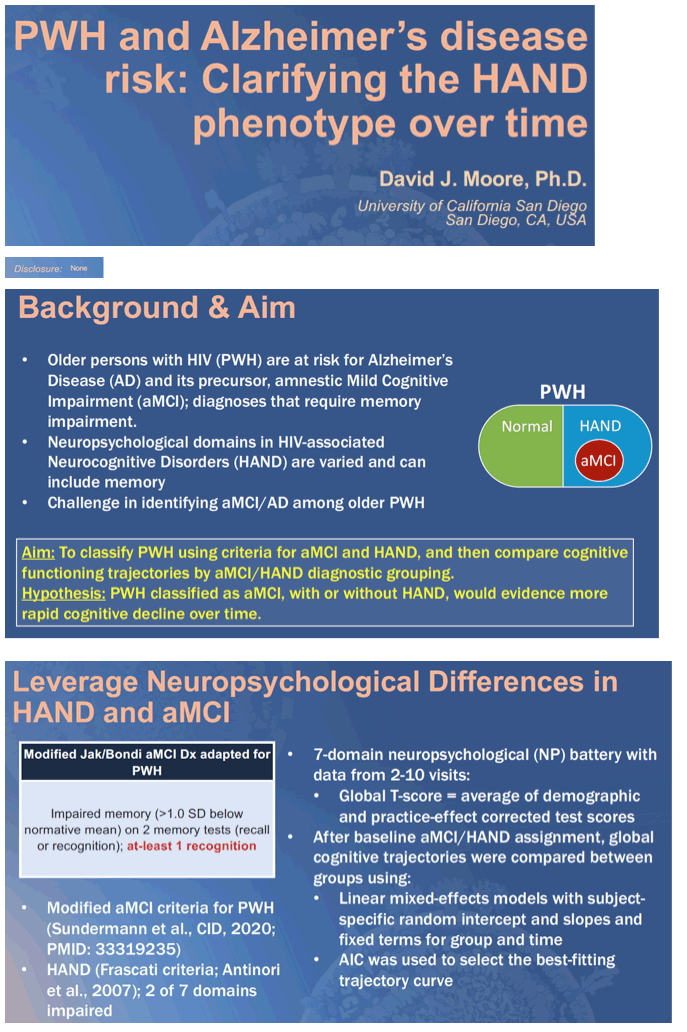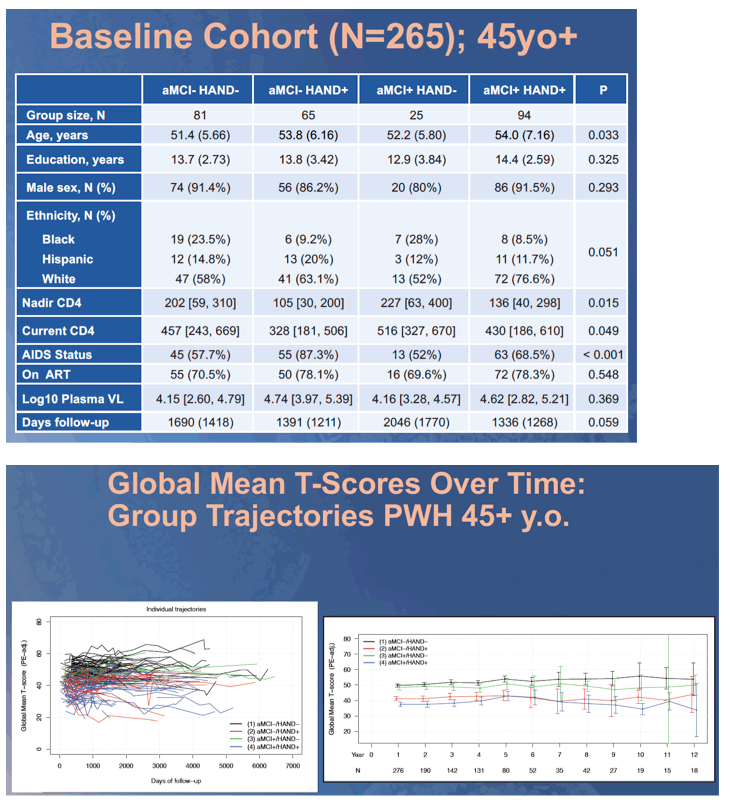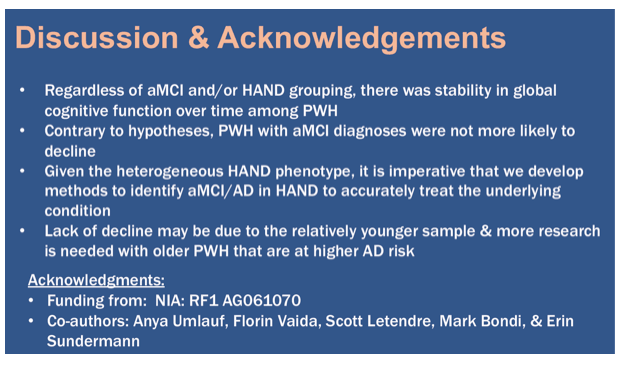 |
 |
 |
| |
PWH AND ALZHEIMER'S DISEASE RISK: CLARIFYING THE HAND PHENOTYPE OVER TIME
|
| |
| |
In this study they corrected for age, the results do not mean that there are no individual PWH who show decline over time, but when you use these diagnostic approaches the lines are stable by group. They are relooking at the data with uncorrected scores too (i.e., not correcting for age). There certainly are some individuals who decline, and, some individuals show decline on the spaghetti plot. Another next step is to use analytic methods to pick out those who decline, as well as those who don't, and see what is unique about those data-driven groups (biologically, demographically, etc.). There is a limitation here in that these individuals are pretty young (45+). In the Alzheimer's research world, investigators are trying to look younger and younger to identify risk for future decline, so that was one of the objectives here. With this middle-aged cohort, we have the unique ability to look over a long period of time (10 years). So, this approach does not pick out the people who decline. They will try this in combination with biomarkers…they are trying to identify those who decline (we know there are some) early in the process and to identify the etiology of the NP decline. Jules
CROI 2021 March 6-10 Reported by Jules Levin
David J . Moore1, Anya Umlauf1, Florin Vaida1, Scott Letendre1, Mark W. Bondi1, Erin E. Sundermann1
1University of California San Diego, La Jolla, CA, USA
Background: Older people with HIV (PWH) are at risk for Alzheimer's Disease (AD) and its precursor, amnestic Mild Cognitive Impairment (aMCI). Whereas aMCI/AD diagnoses require memory impairment, the neuropsychological domains impaired for a diagnosis of HIV-associated Neurocognitive Disorders (HAND) are varied and can include memory, which presents a challenge in identifying aMCI/AD among older PWH. We aimed to classify PWH by both aMCI and HAND status, and then compare cognitive functioning trajectories by aMCI/ HAND diagnosis. We hypothesized that PWH classified as aMCI, with or without HAND, would evidence more rapid decline over time.
Methods: The sample included 265 mid-to-late life (45+ years old) PWH, (89% male and 65% Caucasian) from the HIV Neurobehavioral Research Program (HNRP) and the National NeuroAIDS Tissue Consortium (NNTC). All participants completed a comprehensive 7-domain neuropsychological battery with data from at least two visits (up to 10 visits). We applied neuropsychological criteria to identify aMCI in PWH (Bondi et al., 2014). HAND diagnoses were assigned using the Frascati criteria. After baseline aMCI/HAND assignment, global cognitive trajectories were compared between groups using linear mixed- effects models with subject-specific random intercept and slopes and fixed terms for grouping and time. AIC was used to select the best-fitting trajectory curve.
Results: The diagnostic categorizations were: aMCI+/HAND+ (n=95), aMCI+/ HAND- (n=25), aMCI-/HAND+ (n=65), aMCI-/HAND- (n=81).
As expected, both HAND groups had lower baseline global cognitive T-scores as compared to the non-HAND groups (all ps<0.05; Fig 1). No significant differences were observed between the groups in terms of plasma HIV viral load, duration of HIV disease, or ART treatment status (on/off).
The aMCI+/HAND+ group was, on average, 11 global T-score points lower as compared to the aMCI-/HAND- group. Using the linear (best-fitting) model to examine trajectories over time, we found no significant decline from baseline in any of the aMCI/HAND groups (p=0.28; Fig. 1).
Conclusion: Regardless of aMCI and/or HAND grouping, there was stability in global cognitive function over time among PWH. Contrary to expectations, PWH with aMCI diagnoses were not more likely to decline. Given the heterogeneous HAND phenotype, it is imperative that we develop methods to identify aMCI/AD in HAND to accurately treat the underlying neurobiology.



|
| |
|
 |
 |
|
|